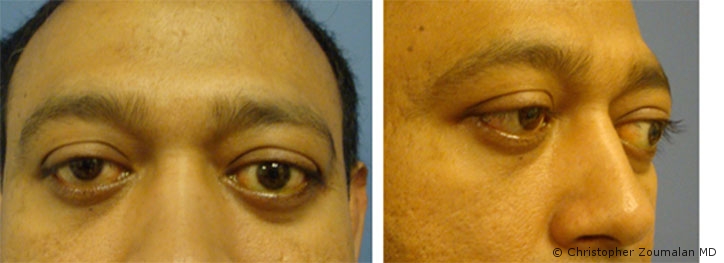Orbital decompression allows the eyes to be set back to a normal position. Many suffer from proptosis due to thyroid eye disease (also known as Graves’ disease), a condition where one or both eyes bulge out. This can lead to both cosmetic deformities and functional vision problems.
Because the eyes are bulging out of a normal position, patients may experience serious exposure of the eye and cornea. This frequently results in eye redness, irritation, corneal issues such as keratopathy, tearing concerns, and potential eye and ocular infections. In more extreme cases, vision loss from optic neuropathy, or pressure onto the optic nerve can occur. Because of the many risks and pain associated with this, orbital decompression is most often the best solution.
For more on orbital decompression and eyelid surgery in Beverly Hills, schedule a consultation with Dr. Zoumalan today.
Causes of Orbital Socket Troubles
For over 80% of cases of thyroid eye disease, also known as T.E.D., Graves disease is often found to be the culprit. Side effects of dealing with Graves disease include frequent inflammation along with the expansion of the orbital fat and extraocular muscle. The condition mainly affects adults in their thirties and forties and if it occurs, T.E.D. can greatly impair daily work and life activities.
The severity of this disease varies widely from individual to individual and can be very unpredictable. Prolonged hypothyroidism and smoking can worsen this condition. In T.E.D., there is both an active phase and an inactive phase. The active phase may last anywhere from 6 months to 3 years. Once finished, the inactive phase begins and fibrosis alongside its commonly debilitating symptoms persist. Most orbital decompression surgeries are performed in the inactive phase. However, in case of an emergency, such as vision loss, surgery must be done immediately.
Orbital Decompression Procedures
For mild to moderate proptosis, orbital fat reduction is typically an appropriate solution to any existing issue. This may be accomplished by removing extraconal and intraconal fat, depending on the patient’s needs. In moderate to more severe cases of proptosis, bony decompression may be needed to restore the proper volume in both the orbital soft tissues and its surrounding orbital bone. This includes removing the bones that comprise the orbit in the eye area. It may be necessary to combine fat decompression with bone removal in some instances to ensure optimal results and relief for existing symptoms. Orbital decompression surgery also assists in reducing proptosis as well as infraorbital pressure. Patients may also experience improved orbital congestion, less corneal exposure, and may also help relieve compressive optic neuropathy.
The Best Candidates for Orbital Decompression
The best candidates for orbital decompression will depend greatly on the desired results and degree of proptosis for each patient. Determining whether a patient is an ideal choice for this surgery can best be decided after a complete clinical examination. This includes a CT or MRI interpretation and patient facial photograph comparisons to determine the severity of the onset of TED. The amount of proptosis is then measured along with upper and lower lid retraction, presence of double vision, and any existing corneal exposure. If you think orbital decompression may be right for you, schedule a consultation with Dr. Zoumalan today.
Orbital Decompression & Eyelid Surgery in Beverly Hills
Dr. Zoumalan specializes in Aesthetic and Reconstructive Oculoplastic Surgery, including orbital decompression and eyelid surgery in Beverly Hills. After many years of study, he achieved the highest levels of esteem and honor in his field. Striving to help his patients achieve their aesthetic goals, Dr. Zoumalan utilizes his years of education, experience, and a compassionate approach to expertly diagnose and treat conditions for cosmetic and functional concerns.


